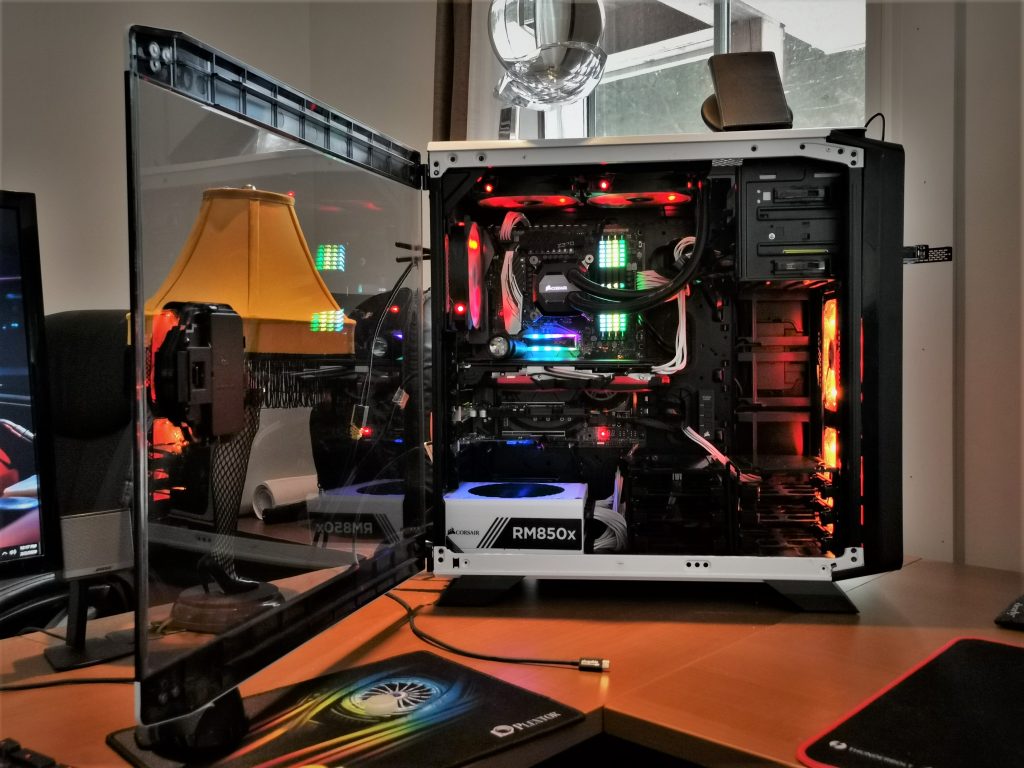TSSDR TEST BENCH AND PROTOCOL
CFexpress Card testing at TSSDR differs slightly, depending on whether we are looking at consumer or enterprise storage media. For our ProGrade Digital CFexpress Type B card testing today, our goal is to test in a system that has been optimized with our SSD Optimization Guide. To see the best performance possible, the CPU C states have been disabled, C1E support has been disabled, and Enhanced Intel SpeedStep Technology (EIST) has been disabled.
SYSTEM COMPONENTS
The components of this Test Bench are detailed below. All hardware is linked for purchase and product sales may be reached by a simple click on the individual item. As well, the title is linked back to the individual build article where performance testing can be validated.
TSSDR ASROCK Z370 TAICHI TEST BENCH (link)
| PC CHASSIS: | Corsair Graphite 760T Arctic White Window Chassis |
| MOTHERBOARD: | ASRock Z370 Taichi |
| CPU: | Intel Coffee Lake Core i7-8770K |
| CPU COOLER: | Corsair Hydro Series H110i GTX |
| POWER SUPPLY: | Corsair RM850x 80Plus |
| GRAPHICS: | MSI Radeon RX570 |
| MEMORY: | Corsair Vengeance RGB 32GB DDR4 3600Mhz C18 |
| STORAGE: | Intel Optane 900P 480GB SSD |
| KEYBOARD: | Corsair Strafe RGB Silent Gaming |
| MOUSE: | Corsair M65 Pro Gaming |
| OS | Microsoft Windows 10 Pro 64 Bit |
PROGRADE CFEXPRESS/XQD SINGLE SLOT MEMORY CARD READER
For our testing today, we are going to be using the Prograde CFexpress/XQD Single Slot Memory Card Reader. It is Thunderbolt 3 at 40Gbps, and reaches data transfer throughput as high as 2.8GB/s, although the maximum for CFexpress is much lower at just over 1700MB/s presently. ProGrade is the ONLY company that manufactures their own Thunderbolt 3 reader, and in fact, the industry in general seems to have fallen short in this area. To date, we know of only two Thunderbolt 3 CFexpress card readers that reach the full performance of CFexpress cards, this and the Sonnet SF3 ThunderBolt 3 dual card reader that we reviewed here.
In comparing the two readers, we really like the fact that the ProGrade reader is bus powered, meaning everything, including power, is routed from the PC in a single 40Gbps Type-C Thunderbolt 3 cable. The Sonnet reader, on the other hand, has a separate plug and adapter that connects to the reader. Having said that, the Sonnet also has two Thunderbolt 3 ports on the back which allows ‘daisy-chaining’ to other devices where the ProGrade reader does not. This, obviously is the give and take of having a separate power source.
If you are a media professional, understanding the difference between USB 3.2 (10Gbps), USB 3.2 Gen 2×2 (20Gbps) and Thunderbolt 3 (40Gbps) is crucial. The norm for today’s card readers is USB 3.2 Gen 2 (10Gbps) which provides performance up to a theoretical 1250MB/s, but reality will show 1050MB/s max. USB 3.2 Gen 2×2 is brand spanking new and, if you find anyone using it for card readers, it will get you as high as 2GB/s. Thunderbolt 3, on the other hand maxes out at 2.8GB/s, and because of the 40Gbps speed, a single cable can also operate other devices such as keyboard, mouse, monitor, or what have you. That’s why we can typically daisy-chain up to six devices with Thunderbolt 3.
The ProGrade Digital Single Slot CFexpress/XQD Card Reader is backward compatible to XQD and instructions are provided in the packaging. It comes with the reader, documentation and a Thunderbolt 3 cable. Something we never expected, is that this device has a magnetic bottom which easily sticks the reader to your laptop.
The ProGrade Thunderbolt 3 CFexpress/XQD Card Reader is priced at $129.99 and can be purchased from ProGrade directly or Amazon.
BENCHMARK SOFTWARE
The software in use for today’s analysis is typical of many of our reviews and consists of Crystal Disk Info, ATTO Disk Benchmark, Crystal Disk Mark, Anvil’s Storage Utilities, AJA, and TxBench. Our selection of software allows each to build on the last and to provide validation to results already obtained.
In addition, we will be closing the report off with our heat, sustained performance and true data transfer testing.
 The SSD Review The Worlds Dedicated SSD Education and Review Resource |
The SSD Review The Worlds Dedicated SSD Education and Review Resource | 


Overall a nice article. One thing to point out is there are big differences in card performance based on card size. Almost all 64GB CFExpressB cards have a low minimum sustained write speed. The ProGrade Gold card you tested is the fastest – the 1TB card – and smaller cards are much slower. The Canon R5 is a very good camera, but file size is what drives performance. The larger files of the Nikon Z7ii and Z9 are more demanding on card performance. Likewise smaller files but faster frame rates have a similar impact – more data to be written per second needs a faster card. The advice you gave is good – make sure you match what and how you use your camera to card choice.